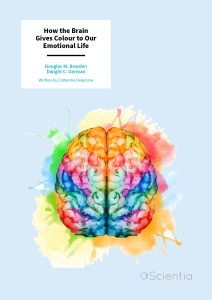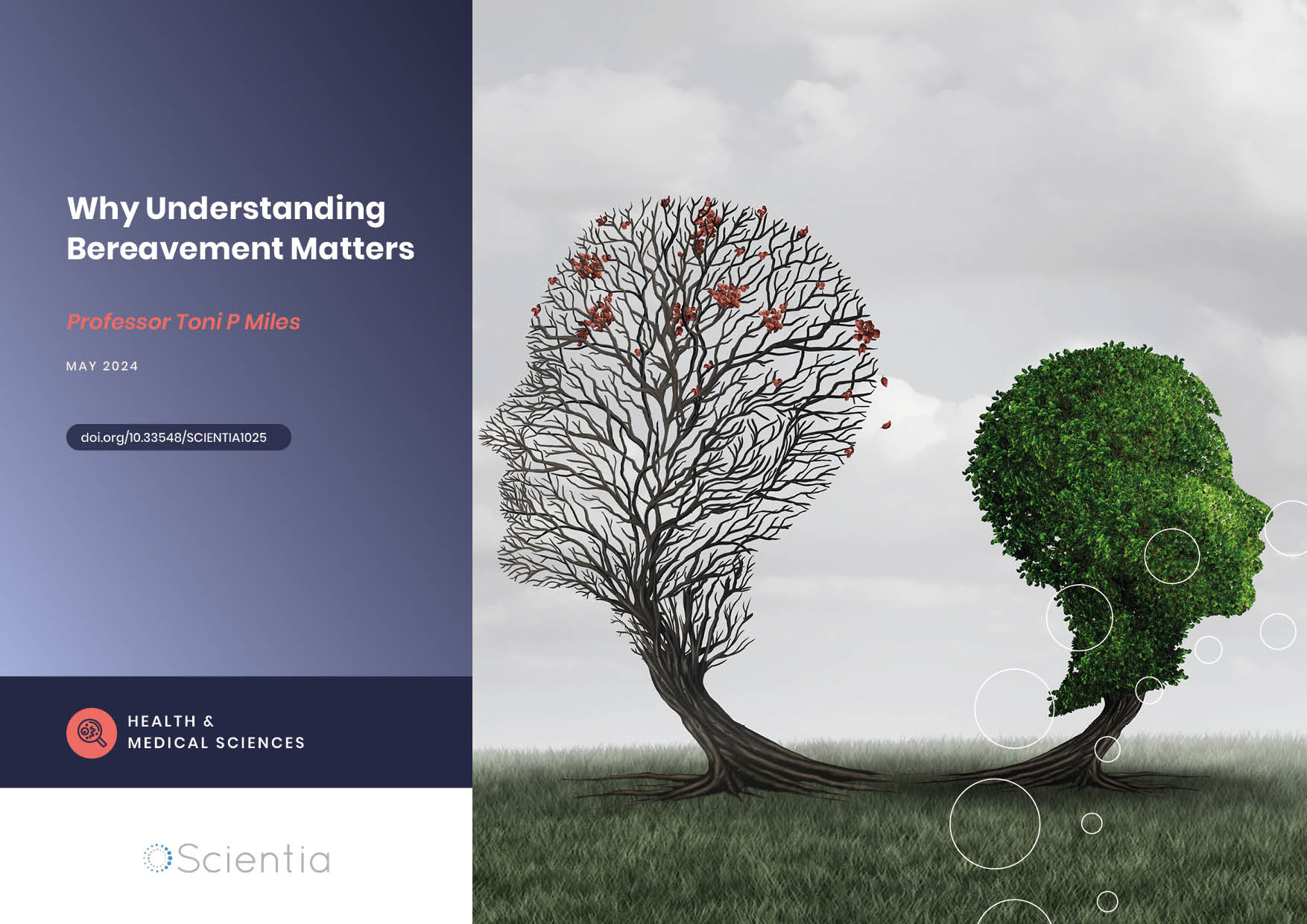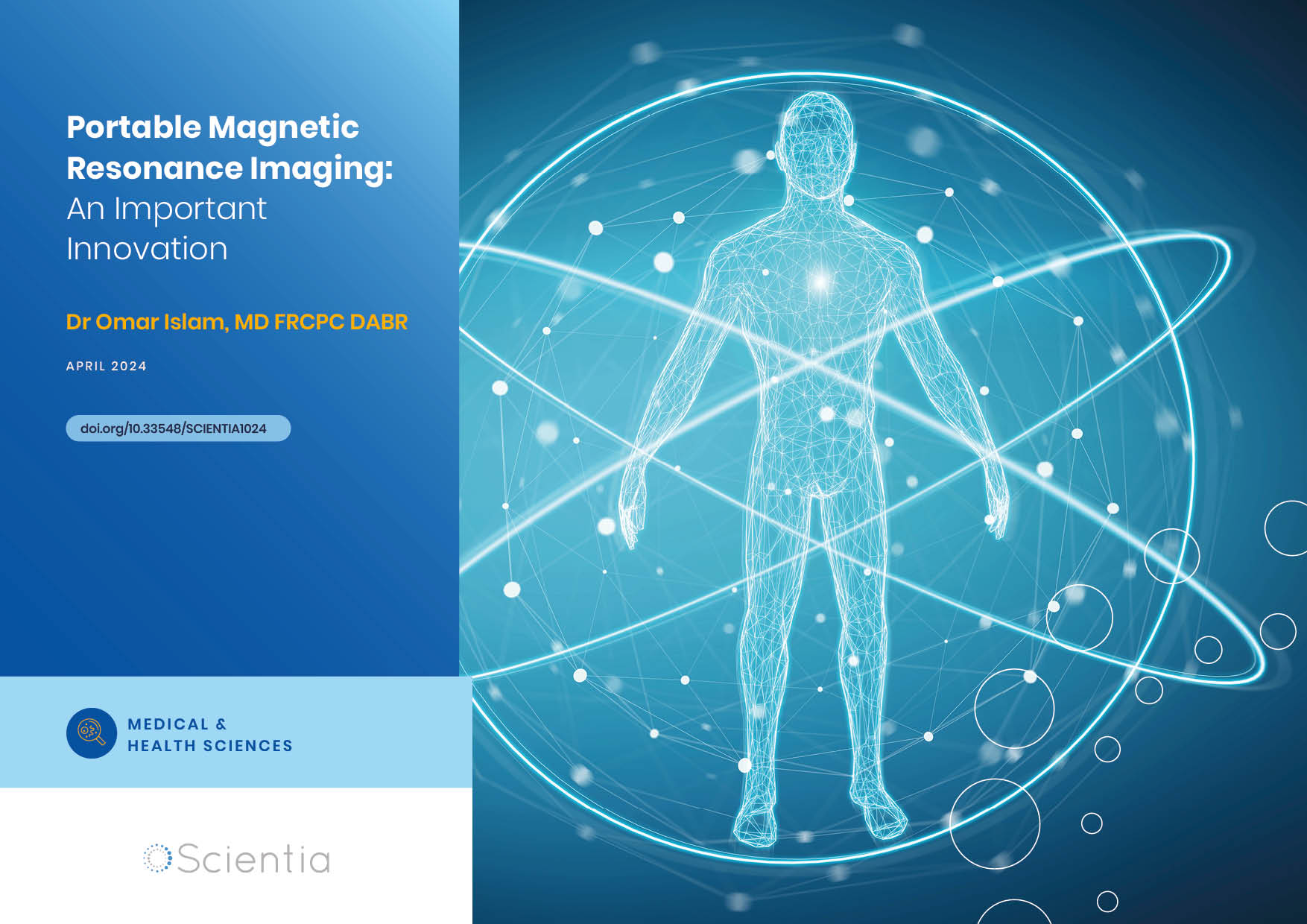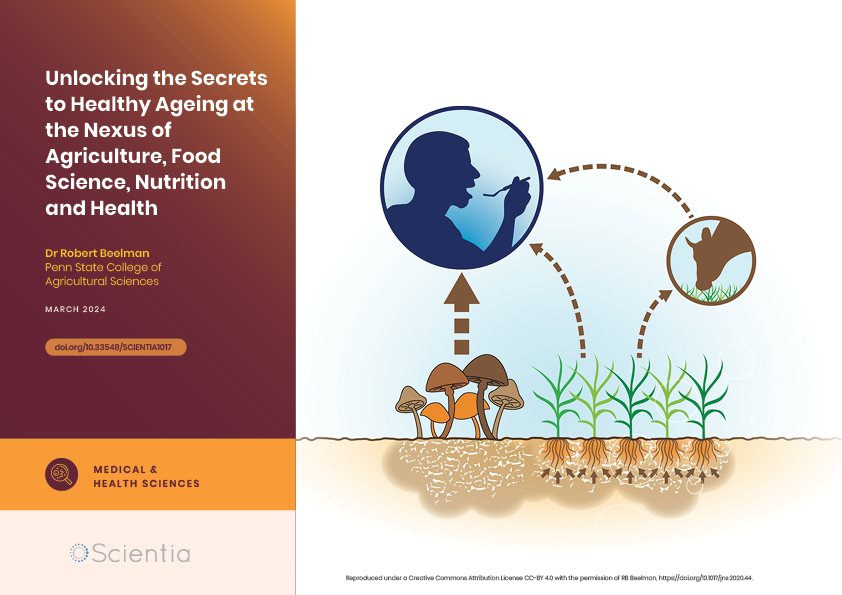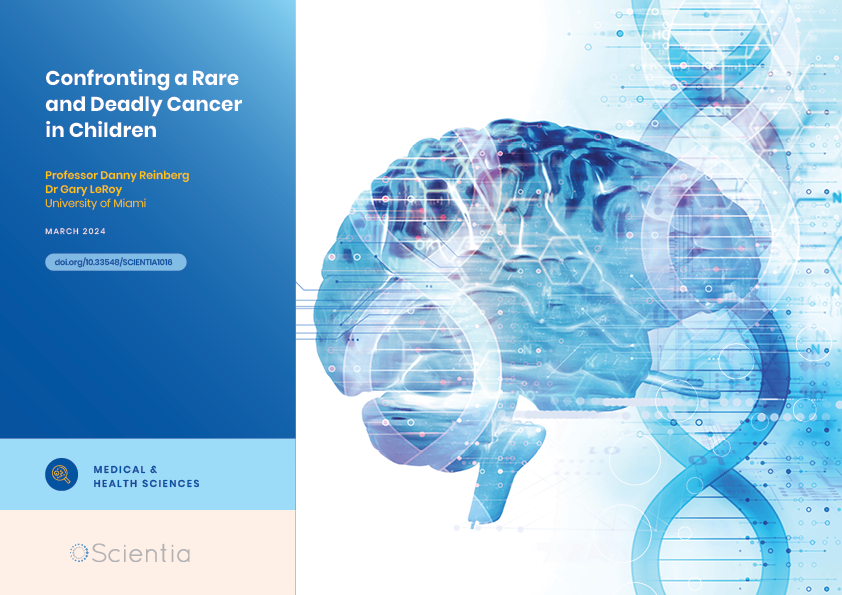Douglas M. Bowden – Dwight C. German | How the Brain Gives Colour to Our Emotional Life
Dr Douglas Bowden (University of Washington School of Medicine) and Dr Dwight German (University of Texas Southwestern Medical Center) recently published an important study shedding new light on the role of dopamine in emotional experience. Placing their intriguing findings into the context of what was already known about dopamine and the primate brain, they proposed a new conceptual framework – the brain as a neurobehavioural control system. This extensive integration of their findings in the monkey with a wealth of neuroscientific knowledge regarding neural mechanisms of human psychological processes provides new insights into the spectrum of emotional experience.
A Monkey Study Sheds New Light on the Role of Dopamine in Emotion
Dopamine, a neurotransmitter found in all mammals, enables communication between neural cells. While dopamine influences many vital processes, including movement, considerable research has converged to show that the neural pathways containing dopamine are particularly involved in emotional behaviour and experience.
A recently published behavioural experiment in monkeys reported by Professors Bowden and German has shed important new light on the role that dopamine plays. They knew from studies by others that if a rat is given the opportunity to stimulate brain areas that contain dopamine by tapping a key, then, if the stimulation is rewarding, the rat will press the key repeatedly. If the stimulation is punishing, it will refuse to press the key.
While similar to that of humans, the rat brain lacks certain structures known to be important in primates. To better determine the rewarding and punishing effects of activating the pathways containing dopamine, the researchers repeated the experiment in monkeys. In their experiment, the monkey received a brief sample of mild electrical stimulation at a tiny test site in a particular brain structure. Then, it was given control of the stimulator. If the stimulation was rewarding (positive), the monkey told them so by pressing the key for repetitive half-second stimulations – typically between 20 and 30 times a minute. If it was punishing (negative), the monkey did not press the key a single time. Some 3,000 sites were tested in this manner. The few studies conducted in humans receiving electrical stimulation of the brain for clinical diagnostic tests had shown that rewarding stimulation was associated with pleasurable feelings and that ‘punishing’ stimulation was associated with stressful, disturbing feelings.
Knowing that mechanical touching, tugging, and even surgical incision of the brain is painless, Professors Bowden and German were surprised to find that 99% of brain structures stimulated electrically yielded sites that were positive and/or negative. Apparently, virtually all parts are involved in the evaluation of electrical signals, the lifeblood of neural signalling in the brain. Twice as many sites were positive as negative, suggesting that more of the primate brain is dedicated to processing information about rewards than punishments. Stimulation of dopamine pathways was generally rewarding, while stimulation of certain other pathways was negative. Surprisingly, however, stimulation of a few dopamine-rich areas was not rewarding, and stimulation of several dopamine-poor areas was very rewarding.
It was clear to Professors Bowden and German that dopamine is not the only factor influencing the role of a structure in the rewarding effect. More influential is the role that a particular brain structure plays in evaluating a stimulus, that is, a person or object, as a potential source of rewarding or punishing interaction, deciding whether to engage or avoid it and formulating an appropriate response.
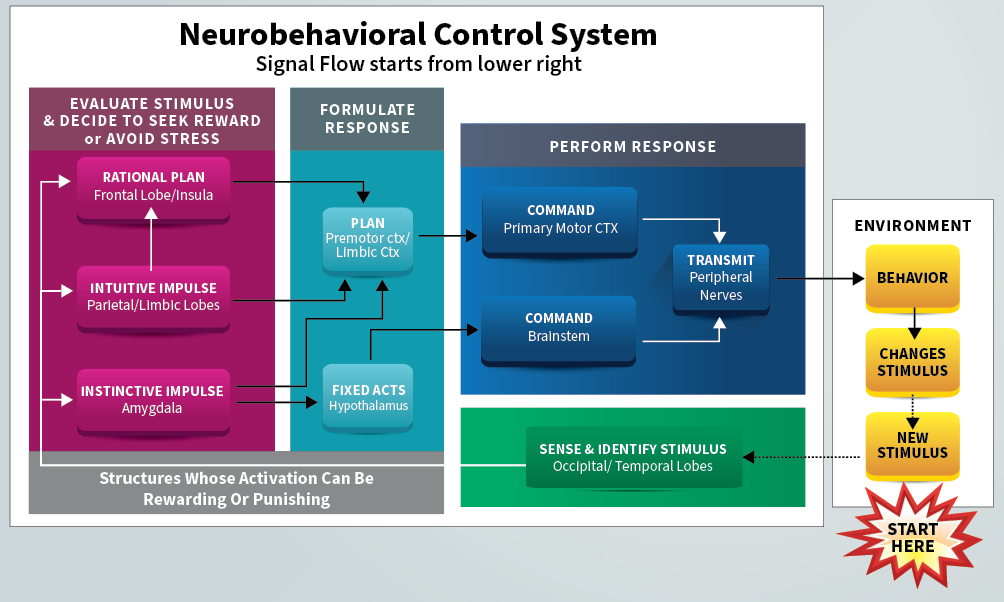
Figure 1. The Neurobehavioral Control System is composed of three subsystems. Green Box: Through common sensory structures each subsystem perceives stimulating events. Magenta Box: it evaluates and decides the direction of a response in central structures, and Light Blue Box: it formulates a response, which controls the performance of the behaviour through Dark Blue Box: motor structures and peripheral nerves. The behaviour influences Yellow Buttons: the environment, which causes a change in the stimulus. Depending on whether the change is sensed as a reward or punishment, the stage is set for another round of adaptive behaviour.
Human Studies Shed Light on How the Brain Generates Emotional Feelings
In the monkey study, the researchers could infer whether activation of a structure was sensed as positive or negative by whether the monkeys pressed a key, but the monkeys could not, of course, report in words what they felt. The feelings of pleasure and, on the flip side, emotional stress are mental functions generated by the brain. They are conscious subjective experiences, the emotional content of which no neuroscientist can identify by objective physiological measures. However, because humans have the ability to report their experiences verbally, scientists have access to objective knowledge of their subjective feelings through verbal recordings of what they feel.
On reviewing more than one hundred studies by other neuroscientists with humans, Professors Bowden and German found that, as in their monkey study, many more structures are involved in emotional experiences than can be accounted for by variations in concentrations and locations of dopamine in the brain. To explain how the brain generates emotional feelings, it was necessary to develop a new model of how the brain works.
Conceptualising the Primate Brain as a Neurobehavioural Control System
Professors Bowden and German integrated their new insights with findings from a host of other neuroscientists to propose that the nervous system of the primate could be most usefully conceptualised as a neurobehavioural control system that consists of nested, overlapping systems. A simplified version of their original model (published in 2021) is shown in Figure 1.
The majority of areas activated when a person experiences different kinds of feelings are located in evaluative and decision-making structures (magenta in Figure 1) as well as response-formulating structures (light blue). No cortical structure is associated with just one feeling – all are involved in more than one emotion, and virtually all are associated with some pleasurable and some stressful feelings.
A recent study in the Proceedings of the National Academy of Sciences (PNAS-US) reported that we are able to distinguish roughly thirty categories of emotion ranging from joy, adoration and aesthetic appreciation to disgust, horror, and hatred. Professors Bowden and German are intrigued by the question of how such a diverse array of distinctly positive and negative emotions relate to the evaluative and decision-making brain structures that respond to electrical stimulation as rewarding or punishing.
This version of the model illustrates three basic systems. Professor Bowden explains, ‘We are designed to interact with others partially on the basis of brain circuitry that is innate and genetically hardwired for ‘common-sense’ reactions by two systems: instinctive and intuitive and partially by a rational system that is constantly rewiring itself in adaptation to a changing environment’.
An instinctive impulse in response to a stimulus is an automatic ‘fixed action sequence’ common to all members of the species. For example, a person about to be hit in the face by a hard ball raises an arm to fend it off without conscious awareness that they are doing so. Such a response is mediated by activation of a short pathway (lower tier, Figure 1, that is, a short sequence of neurons carrying signals of the stimulus from the eye to the amygdala (AMG, #7 in Figure 2B) for evaluation as an attraction to approach or a threat to avoid, thence to the hypothalamus for activating the response, and out through nerves to the arm and neck muscles that perform the response. For a threat, the behavioural response is generally over before one feels an emotion of pain if hit. If not hit, a negative emotion, such as anger or fear, may follow as one contemplates what might result should the threat event happen again.
An intuitive impulse or thought involves conscious awareness. It may occur as an impulse to approach or avoid a person based on a glimpse of them at a social gathering. Or, surprisingly, it may occur as a eureka moment when the eye of a mathematician observing a complex set of equations on a blackboard suddenly intuits a solution, E = mc2, for example, and extends an arm to write it down. Einstein is widely quoted as saying, ‘The intuitive mind is a sacred gift, and the rational mind is a faithful servant’. A postmortem study of his brain showed that the ‘deciding structures’ of the intuitive and rational systems were considerably larger than in most people.
Intuitive behaviours (magenta, middle tier, Figure 1), controlled largely by the parietal lobe (Figure 2A), are mediated through two major pathways from the sensory side to the muscle action side in the nervous system. The pathways are combined in their course from the eye to the posterior parietal cortex (PPC, #10 in Figure 2C). There, the stimulus is evaluated for usefulness. This pathway accounts for the ‘monkey see, monkey do’ mode of learning. For example, a friend shows a useful app, which is immediately recognised as a new tool. Or the PPC receiving the signal of a person glimpsed across the room might evaluate them as ‘useful’ to engage in conversation. If so, it decides to approach and forwards the signal to the premotor cortex (PMC, #11 in Figure 2C) to formulate a plan, a series of actions to reach that goal: thread one’s way to the person, wait until they are free and introduce oneself.
At the same time, PPC sends the signal by a second route to the posterior cingulate cortex (PCC, #1 in Figure 2B). PCC combines the signal with signals it receives from many other areas and decides whether the person is genuinely worthy of approach, that is, authentic or fake. PCC is at the back of the limbic lobe, which has long been recognised as a mediator of emotional behaviour. So, a decision of ‘authentic’ may be associated with positive emotion, and a decision of ‘fake’ with negative. PCC sends signals of authenticity or fakeness to the midcingulate cortex (MCC, #2, Figure 2B), which sends a signal to the motor command pathways that are separate from the command transmitted through the PMC (#11). Evaluations and formulations of the two pathways for a familiar stimulus usually match. Both send their signals to the command structures that coordinate the patterns of muscle contractions and relaxations for smooth performance of the behaviour. If they do not match, signalling a possible fake, one may feel negative frustration and abandon the approach.
The Instinctive and intuitive systems are composed of innate pathways selected for their value in adaptation through tens of millions of years of primate evolution. They are triggered to action by physical and social stimuli so common that they have become ‘hardwired’ into every human brain. Differential development of such pathways in people genetically equipped to perform particular roles in human society presumably accounts for much of the lifelong gender, familial, and temperamental variation in the behaviour of individuals.
The innate systems account for instantaneous responses to common stimuli. However, our most immediate reactions may not always be the most advantageous – and for such situations, evolution has equipped our species with a higher-order rational control system (top tier of the magenta panel in Figure 1). A rational plan or thought is based on logical consideration of a new stimulus in the context of current reality and planning the actions most likely to result in a pleasurable experience and/or avoid a stressful one. The rational system has the ability to inhibit instinctive and intuitive reactions when appropriate and, thus, to favour reactions that have a greater probability of being advantageous. As Professor Bowden notes, “When we speak of ‘self-control’, we refer to this rational system as logically prioritising possible reactions generated by the three systems based on the likelihood that they will result in reward, rather than punishment, or nothing at all”.
The rational system, controlled largely by the frontal lobe (Figure 2A), is similar to the intuitive system in that two separate major pathways lead from the eye to the top decision area, the lateral prefrontal cortex (LPFC, #12, Figure 2C). It differs by much greater complexity. It has six major evaluating, decision-making, and response-formulating structures compared to the intuitive system’s three structures and the instinctive system’s two structures.
One pathway connects evaluative areas in the insula (insular lobe, INS, #13, Figure 2C), which detects largely negative smells, tastes and pains from both inside and outside the body, the orbital prefrontal cortex (OPFC, #5, Figures 2B and 2C), which further evaluates stimuli for significance relative to riskiness and ethical principles of right and wrong, the medial prefrontal cortex (MPFC, #3, Figure 2B), which evaluates the significance of the stimulus to another person involved; and the anterior cingulate cortex (ACC, #6, Figure 2B) for overall attractiveness or threat. Evaluations by those structures are transmitted to LPFC (#12) for logical consideration and thence to PMC (#11) for integration with input from the intuitive system and formulation of a rational response. Simultaneously, stimulus signals from the sensory organs are transmitted by a direct pathway to the frontal pole (FP, #4, Figures 2B and 2C). If a rational decision forwarded by LPFC (Plan A) has proven unsuccessful recently, LPFC queries FP for a Plan B, which it forwards to PMC.
Critical to the rational system is its ability, unlike the instinctive and intuitive systems, to rewire itself in adaptation to the ever-changing world we inhabit. Professor Bowden explains, ”Decade-to-decade changes in technology and social mores mean that humans must adapt to the continuously evolving rules of legal and ethical behaviour that govern the administration of rewards and punishments in contemporary society.” We now know that dopamine is the substance that cements new connections between neurons along successful pathways from sensory organs to organs of muscular control.
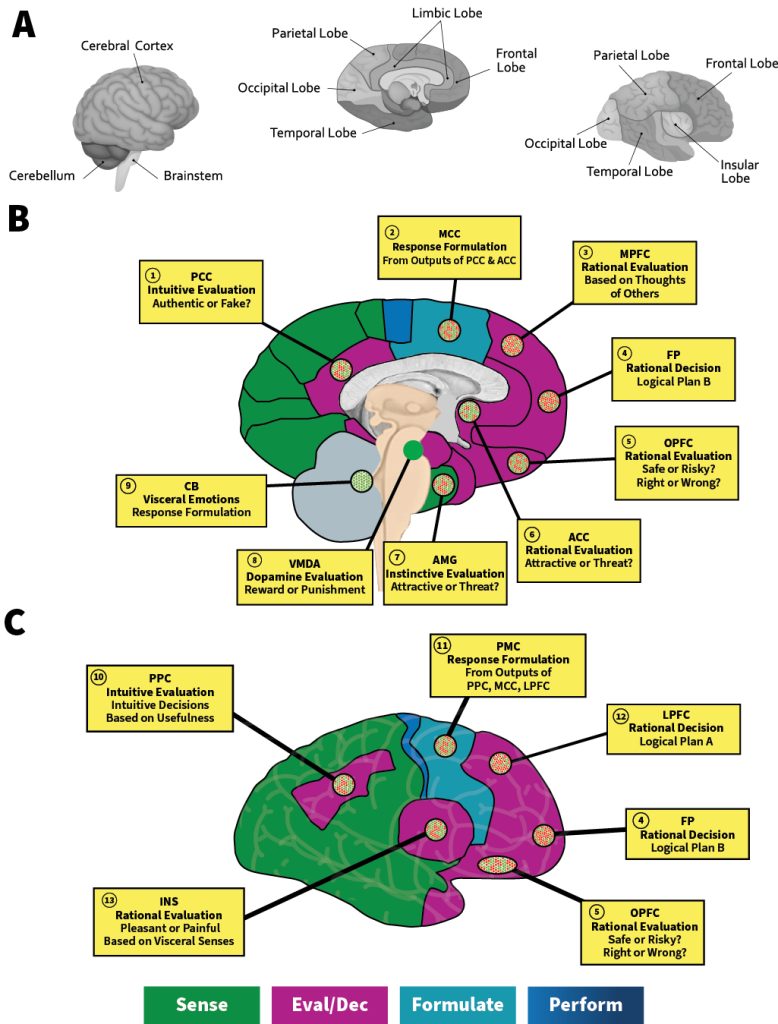
Figure 2. Anatomical Structures Involved in Emotional Experiences. 2A Left: three major parts of the brain; Right: six lobes of the cerebral cortex. 2B Medial view of the left hemisphere; colours correspond to boxes in Figure 1. Green: sensory structures; Magenta: evaluative and decision-making structures; Light Blue: response formulation structures; Dark Blue: response performance structures. Ovals: diagrammatic microscopic ‘windows’ onto the random distribution of nerve cells in a structure. Green Dots: cells activated by positive, rewarding stimulation in the monkey study; Red dots: cells activated by negative, punishing stimulation. Relative numbers of green and red dots represent the approximate proportions of cells responsive to positive and negative stimulation.
Neural Mechanisms of Stressful Emotions
Emotions are the psychological accompaniments of the physiological formulation processes activated during the production of a behavioural response to a stimulus, particularly another person. Because the three systems operate simultaneously, many brain structures are activated when one experiences a particular emotion. The character of the emotion is determined by the combination of structures that contribute to it. For example, if a boss belligerently criticises an employee for failing to produce an acceptable report by a short deadline, the employee is likely to experience one or more of three negative emotions: anger (a feeling of hostility toward another person), fear (a feeling associated with the belief that the other is more powerful and a threat), and/or guilt (a feeling of being at fault in having committed an offence toward another).
Of the three, anger is the simplest and perhaps evolutionarily most primitive. Associated with aggressive ‘fight’ responses, anger involves the least number of evaluative, decision-making and response-formulating structures. If an editorial boss’s belligerent criticism produces a feeling of anger, it may be associated behaviorally with shouting and shaking a fist in the boss’s face. Physiologically, it is associated with the activation of several structures: the instinctive AMG (#7), the control locus of automatic defensive behaviour; the intuitive posterior cingulate cortex (PCC, #1), locus of evaluation of the boss as authentic vs. fake, that is, as an editorial expert or just an ignorant pretender; the rational ACC (#6), which evaluates the outcome of the boss’s belligerence based on previous interactions; and FP (#4), locus of a Plan B in case earlier Plan A responses failed.
Compared to anger, fear and guilt involve twice the number of evaluative, decision-making and response-formulation structures. Apparently, fear and guilt involve more mental processing than anger. A feeling of guilt may reflect reasoning that, in some respects, the boss is right. The employee recognises that more effort might have been given to the preparation of the report, which the boss justifiably judges unfit.
Structures activated with guilt, as with anger, are found in all three behavioural control systems. They include the same instinctive evaluator for threat and danger (AMG, #7), the intuitive evaluator for authenticity vs falsity (PCC, #1) and (PPC, #10), the intuitive decider to engage or ignore a threat based on potential utility or liability of such action. Structures involved in guilt include, in addition, a number of other parts of the frontal lobe’s rational system in OPFC (#5), the evaluative locus of moral values and probabilistic calculations of potential risks and benefits to other courses of action, Plans B in the FP (#4), such as, offer an apology and/or pledge to stay late and fix the report…alternative responses that might protect him or her from punishment and possible loss of job for insubordination.
Fear involves most of the same structures as anger and guilt. In addition, it involves the activation of MCC (#2, Figure 2B). Long recognised as the primary processor of emotional information, MCC receives evaluative information from all three neurobehavioral control systems: instinctive information from the AMG (#7), intuitive evaluation from PCC (#1), and rational evaluation from ACC (#6). It forwards the integrated emotional evaluations to PMC (#11), which further integrates the combined emotional information with decision information from the rational and intuitive systems (LPFC, #12 and PPC #10, respectively). The PMC (#11) is, thus, the final common pathway for instinctive, intuitive, and rational evaluations. It formulates a response with the greatest probability of achieving reward and avoiding punishment.

Figure 3. Settings Conducive to Romantic Love in Teens: Upper Left, Graduate Students: upper right, and Young Professionals: lower centre. Note the progression of romantic love from social conviviality to personal intimacy signalled by 1) ambient objects and location: from book bag for her, sports equipment for him, in an exhilarating bright sunny, pop-musically rousing soda shop (upper left) to glasses of fine wine and roses in a quiet, cozy and softly lit dining room and 2) the progression from excited sharing of opinions about everything in their lives through the first fond gaze into the eyes of a friend-becoming-loved-one to the first tentative tingling touch of gentle hands
Neural Mechanisms of Positive Emotions
Activation patterns of an even greater variety are found among structures involved in the most passionate and sometimes most stressful emotions, namely, those activated with the complex behavioural repertoires of courting, mating, parenting, and weaning of offspring. Interestingly, the most positive of those emotions – ‘love’ – does not appear in the comprehensive list of the PNAS-US report. The word ‘love’ has, in modern parlance, become an ambiguous term covering two overlapping behavioural processes that are associated with quite distinct emotions: romantic love and sexual desire.
The kinds of modern settings for pleasurable courting associated with feelings of romantic love are illustrated in Figure 3. Researchers studying romantic love using noninvasive imaging technology ask a person to gaze at a photo of one they love and to maximise the strength of their feelings for the other. The overall emotion is an integration of feelings produced by a particular subset of evaluative, decision-making, and response-formulating structures. In romantic love, the same structures are involved in men and women as each explores areas of common knowledge, common values and exotic differences in the other’s life experiences.
Investigators led by Janniko Georgiadis at the University of Groningen, The Netherlands, have conducted a fascinating series of studies on the neural mechanisms of courting, mating, and parenting in humans. They and others have shown that structures activated in romantic love include INS (#13), the rational system structure that evaluates touch sensations and internal sensations, such as heart palpitations and ‘gut feelings’. Other structures activated are the ‘small brain’ – the cerebellum (CB, #9, Figure 2B). The CB is activated by touch stimulation of erogenous zones, which may account for the psychological tendency to merge concepts of romantic love and sexual desire.
The purity of romantic feelings is enhanced by the deactivation of intuitive and rational structures, which, in other settings, inhibit the neural mediators of risky behaviour and avoidance of dangerous interactions with unfamiliar individuals. Remarkably, most evaluative and decision-making structures of the three behavioural control systems are deactivated, including the threat-sensitive instinctive AMG (#7), the falsity-detecting PCC (#1) and the uselessness-detecting PPC (#10) of the intuitive system. Rational control is undercut by the deactivation of the LPFC (#14), the locus of decisions in long-term planning, and MPFC (#3), the source of empathy for another’s negative feelings, which would be minimal in a romantic love setting. Such extensive deactivation of self-protective processes no doubt accounts for the absence of self-control captured in such common expressions as ‘love is blind’, ‘madly in love’, and Ambrose Bierce’s cynical definition: ‘Love: A temporary insanity, curable by marriage’.
Of course, even the most passionate of lovers do not live 24/7 exploring each other’s cognitive and emotional universes. When apart, they may muse on the practical implications of a long-term day-in-day-out relationship. Both brains drift into what neurocognitive scientists call ‘default mode’. The neural focus of attention shifts from the external world, the attractive person, to internal consideration of the prospects for a long-term relationship based on reasoning and intuitions from one’s own personal experiences, observation of other couples’ relationships, and accounts by family and friends of how the person might appear and behave in other settings.
As one might suspect, structures activated in default mode are largely the same as those deactivated in romantic love. Activation of the intuitive PCC (#1) might raise questions of whether the other is authentic, more graphically: ‘Is he as he appears in gentleman’s attire – or a jerk in disguise?’. Default activation of OPFC (#5) and LPFC (#12) might evaluate compatibility: ‘Do we share common values with regard to assuming responsibility? ethics? kids and parenting?’ Activation of PMC (#11) might produce plans for fulfilling the personal and professional dreams of both, considering realistic challenges posed by different locations of jobs, relatives, and lifelong friends. Psychologically mature couples discuss such issues in good faith and decide whether to proceed from courting to mating to parenting and living happily ever after. Some decide yes, and some decide no. If they are unable to see a rational plan for a fulfilling life together, they may agree to part and go their separate ways.
What are the chances of establishing a lifelong, loving relationship in today’s complex and uncertain society? Some anthropologists observe that the half-life of romantic feelings is about four years. Popular wisdom describes romantic decline terminating in a ‘seven-year itch’. Considering the number of obstacles to a lifelong relationship, it is encouraging and perhaps remarkable that in current U.S. society, the first marriage of half of men and women continues for more than a quarter-century.
A Critical Basis for Delving Deeper
The work of Professors Bowden and German represents a tremendous advance in relating modern neuroscience to everyday life experiences. Each has dedicated more than 50 years to understanding the complex interactions between the mind, brain, and body. Their analytic tenacity, synthesis of knowledge, and reflective insights have culminated in the first unified neuroscientific account of some of the most fundamental aspects of human nature. But the story does not end there. Professors Bowden and German have developed an empirically and theoretically sound analytic framework that will enable scientists to delve deeper and further into how the entire nervous system works, and they have illustrated its value by showing how the brain gives colour to our emotional life.
SHARE
DOWNLOAD E-BOOK
REFERENCE
https://doi.org/10.33548/SCIENTIA1004
MEET THE RESEARCHER

Professor Douglas M. Bowden, MD
Department of Psychiatry and Behavioral Sciences,
University of Washington School of Medicine,
National Primate Research Center, UW,
Seattle,
WA, USA
Professor Douglas Bowden completed a BA in Psychology at Harvard University in 1959, and in 1965, he completed his MD studies at Stanford University. He followed this by undertaking a range of advanced research training positions, which included appointments in the neurobehavioral sciences at Moscow State University (USSR), the Max Planck lnstitute for Psychiatry (Munich), and the National Institute of Mental Health (Bethesda, USA) before being appointed to the faculty at the University of Washington School of Medicine (Seattle, USA) in 1969. In 1979, he was appointed Professor and is now Professor Emeritus. Highlights of his tenure include the development of a Research Track for Residents in the Department of Psychiatry and Behavioral Sciences and conducting several extensive primate research projects. In addition to work on the reward and stress systems of the brain, topics included foetal alcohol syndrome, the effects of alcohol on social behaviour, and ageing. He is the primary author of the BrainInfo/NeuroNames website and was Director of the National Primate Research Center at UW between 1988 and 1994. Inspired by pioneers in psychology and neuroscience, Professor Bowden – son of a scientifically oriented mechanical engineer turned Professor of Philosophy of Religion – has authored, translated or edited eight texts and more than 130 other scientific publications.
CONTACT

Professor Dwight C. German, PhD
Department of Psychiatry
UT Southwestern Medical Center
Dallas, TX
USA
Professor Dwight C. German completed his PhD training at the University of Oklahoma Health Sciences Center in 1972. After that, he was a Post-Doctoral Fellow in the Department of Physiology and Biophysics and Regional Primate Research Center at the University of Washington. In 1975, he was appointed Assistant Professor in the Department of Physiology at the University of Texas Southwestern Medical Center in Dallas, where he rose through the academic ranks, culminating in his appointment as Professor in the Department of Psychiatry in 1989, a position he still holds. Over the course of his career, Professor German has published prolifically in prestigious journals. For example, he published the neuropathological analysis for a large primate study, demonstrating decisively that childhood vaccines do not cause autism. He holds five patents arising from his research, and has been awarded substantial funding over the past 50 years to support his valued and inspirational contributions to science. Currently, Professor German is engaged in the development of blood biomarkers for neurodegenerative diseases (Alzheimer’s disease and Parkinson’s disease) and neurodevelopmental diseases (autism spectrum disorder). The blood test for neurodegenerative diseases should be available in clinics next year.
CONTACT
E: dwight.german@utsouthwestern.edu
W: profiles.utsouthwestern.edu/profile/12533/dwight-german.html
KEY COLLABORATORS
Mark F Dubach, Department of Psychiatry and Behavioral Sciences and National Primate Research Center, University of Washington, Seattle, USA
Evan Song, University of Washington, Seattle, USA
FUNDING
National Center for Research Resources
National Institute of Mental Health
National Institutes of Health
U.S. National Library of Medicine
Zigenbein Foundation
ACKNOWLEDGEMENTS
Professors Bowden and German are grateful for the insightful review comments provided by Bilal Kahn (UT Southwestern Medical Center) and the writing, editing, and design teams at Science Diffusion.
FURTHER READING
DM Bowden, DC German, Mapping reward mechanisms by intracerebral self-stimulation in the rhesus monkey (Macaca mulatta), Journal of Comparative Neurology, 2021, 529(16), 3564–3592. DOI: https://doi.org/10.1002/cne.25188
AS Cowen, D Keltner, Self-report captures 27 distinct categories of emotion bridged by continuous gradients, Proceedings of the National Academy of Sciences of the United States of America, 2017, 114(38), E7900–E7909. DOI: https://doi.org/10.1073/pnas.1702247114
JR Georgiadis, ML Kringelbach, JG Pfaus, Sex for fun: a synthesis of human and animal neurobiology, Nature Reviews Urology, 9(9), 486–498. DOI: https://doi.org/10.1038/nrurol.2012.151

REPUBLISH OUR ARTICLES
We encourage all formats of sharing and republishing of our articles. Whether you want to host on your website, publication or blog, we welcome this. Find out more
Creative Commons Licence (CC BY 4.0)
This work is licensed under a Creative Commons Attribution 4.0 International License. 
What does this mean?
Share: You can copy and redistribute the material in any medium or format
Adapt: You can change, and build upon the material for any purpose, even commercially.
Credit: You must give appropriate credit, provide a link to the license, and indicate if changes were made.
SUBSCRIBE NOW
Follow Us
MORE ARTICLES YOU MAY LIKE
Professor Toni Miles | Why Understanding Bereavement Matters
Professor Toni Miles has dedicated her research efforts to measuring bereavement and its impact on population health. Individual experience with bereavement is commonplace, but we know little about its impact on society when there is an instantaneous experience by a large number of individuals, i.e., mass bereavement. To measure its occurrence, her research with colleagues first confirmed that bereavement can be effectively measured in population surveys. Professor Miles argues that we should use such approaches to deliver interventions aiming to reduce the negative consequences of bereavement on individuals. By measuring bereavement in communities, these data become a cost-effective way to increase resilience, reduce demands on healthcare systems, and enhance public safety.
Dr Omar Islam | Portable Magnetic Resonance Imaging: An Important Innovation
Imaging technologies are vital in modern medicine and have revolutionised how clinicians make diagnoses and monitor disease progression. However, the necessary equipment – such as a scanner for magnetic resonance imaging (MRI) – is very large and expensive, requiring patients to go to the scanner rather than receiving scans as bedside care. This takes up valuable staff time and resources, and can present further risks to patients. Dr Omar Islam from Queen’s University and Drs Aditya Bharatha and Amy Lin from the University of Toronto are showing how portable MRI scanners may offer a viable alternative that benefits patients and healthcare systems.
Dr Robert Beelman | Unlocking the Secrets to Healthy Ageing at the Nexus of Agriculture, Food Science, Nutrition and Health
Dr Robert Beelman is Professor Emeritus of Food Science and the Director of the Center for Plant and Mushroom Foods for Health at Penn State College of Agricultural Sciences. His groundbreaking research on the medicinal properties of mushrooms and vital nutrients like Ergothioneine has opened new pathways in understanding the link between diet, soil health, and human longevity.
Professor Danny Reinberg – Dr Gary LeRoy | Confronting a Rare and Deadly Cancer in Children
A diagnosis of cancer is never welcome but is particularly devastating when a child is found to have diffuse intrinsic pontine gliomas – a rare but particularly aggressive and treatment-resistant malignancy in the brain. In this article, we focus on the contributions of Professor Danny Reinberg and Dr Gary LeRoy at the University of Miami-Miller School of Medicine to understanding what makes these tumours so dangerous and, importantly, to developing much-needed approaches to improve the outcomes for these children.

